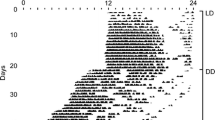Abstract
The role of the period of the environmental cycle during gestation and infancy on the circadian period of adult hamsters was studied. Tau-mutant hamsters of all three genotypes (+/+, 24-h circadian period; +/tau, 22-h period; tau/tau, 20-h period) were conceived and raised under either a 20-h light-dark cycle or a 24-h cycle. The circadian period in constant darkness was determined at 2 months of age by inspection of records of running-wheel activity. Differences in circadian period of up to 1.2 h were observed. However, changes of the same magnitude were also observed in animals conceived and raised under a 24-h cycle and exposed to a 20-h cycle at 8 months of age. Therefore, it is concluded that the aftereffects of entrainment can account for the apparent influence of the early environment. The free-running period of the circadian pacemaker seems to be under complete genetic control and not to be influenced by the period of the environmental cycle under which the animal is raised.
Similar content being viewed by others
REFERENCES
Aschoff, J. (1981). Freerunning and entrained circadian rhythms. In Aschoff, J. (ed.), Handbook of Behavioral Neurobiology, Vol. 4. Biological Rhythms, Plenum, New York, pp. 81–93.
Biello, S. M., and Mrosovsky, N. (1996). Phase response curves to neuropeptide Y in wildtype and tau mutant hamsters.J. Biol. Rhythms 11:27–34.
Crosthwaite, S. K., Dunlap, J. C., and Loros, J. J. (1997). Neurospora wc-1 and wc-2: Transcription, photoresponses, and the origins of circadian rhythmicity.Science 276:763–769.
Davis, F. C., and Menaker, M. (1981). Development of the mouse circadian pacemaker: Independence from environmental cycles.J. Comp. Physiol. 143:527–539.
Hall, J. C. (1990). Genetics of circadian rhythms.Annu. Rev. Genet. 24:659–697.
King, D. P., Zhao, Y., Sangoram, A. M., Wilsbacher, L. D., Tanaka, M., Antoch, M. P., Steeves, T. D., Vitaterna, M. H., Kornhauser, J. M., Lowrey, P. L., Turek, F. W., and Takahashi, J. S. (1997). Positional cloning of the mouse circadian clock gene.Cell 89:641–653.
Menaker, M., and Refinetti, R. (1993). The tau mutation in golden hamsters. In Young, M. (ed.), Molecular Genetics of Biological Rhythms, Marcel Dekker, New York, pp. 255–270.
Menaker, M., Moreira, L. F., and Tosini, G. (1997). Evolution of circadian organization in vertebrates.Braz. J. Med. Biol. Res. 30:305–313.
Pickard, G. E., Sollars, P. J., Rinchik, E. M., Nolan, P. M., and Bucan, M. (1995). Mutagenesis and behavioral screening for altered circadian activity identifies the mouse mutant, Wheels. Brain Res. 705:255–266.
Pittendrigh, C. S. (1981). Circadian systems: General perspective. In Aschoff, J. (ed.), Handbook of Behavioral Neurobiology, Vol. 4. Biological Rhythms, Plenum, New York, pp. 57–80.
Pittendrigh, C. S., and Daan, S. (1976). A functional analysis of circadian pacemakers in nocturnal rodents. I. The stability and lability of spontaneous frequency.J. Comp. Physiol. 106:223–252.
Possidente, B., and Stephan, F. K. (1988). Circadian period in mice: Analysis of genetic and maternal contributions to inbred strain differences.Behav. Genet. 18:109–117.
Ralph, M. R., and Menaker, M. (1988). A mutation in the circadian system of the golden hamster.Science 241:1225–1227.
Ralph, M. R., Foster, R. G., Davis, F. C., and Menaker, M. (1990). Transplanted suprachiasmatic nucleus determines circadian period.Science 247:975–978.
Refinetti, R. (1996). Ultradian rhythms of body temperature and locomotor activity in wild-type and tau-mutant hamsters.Anim. Biol. 5:111–115.
Refinetti, R., and Menaker, M. (1992a). Evidence for separate control of estrous and circadian periodicity in the golden hamster.Behav. Neur. Biol. 58:27–36.
Refinetti, R., and Menaker, M. (1992b). The circadian rhythm of body temperature of normal and tau-mutant golden hamsters.J. Therm. Biol. 17:129–133.
Refinetti, R., and Menaker, M. (1993). Independence of heart rate and circadian period in the golden hamster.Am. J. Physiol. 264:R235-R238.
Refinetti, R., and Menaker, M. (1997). Is energy expenditure in the hamster primarily under homeostatic or circadian control? J. Physiol. 501:449–453.
Sehgal, A., Rothenfluh-Hilfiker, A., Hunter-Ensor, M., Chen, Y., Myers, M. P., and Young, M. W. (1995). Rhythmic expression of timeless: A basis for promoting circadian cycles in period gene autoregulation.Science 270:808–810.
Shimomura, K., and Menaker, M. (1994). Light induced phase shifts in tau mutant hamsters.J. Biol. Rhythms 9:97–110.
Turek, F. W., and Van Reeth, O. (1996). Circadian rhythms. In Fregly, M. J., and Blatteis, C. M. (eds.), Handbook of Physiology, Section 4: Environmental Physiology, Oxford University Press, New York, Vol. 2, pp. 1329–1359.
Vitaterna, M. H., King, D. P., Chang, A. M., Kornhouser, J. M., Lowrey, P. L., McDonald, J. D., Dove, W. F., Pinto, L. H., Turek, F. W., and Takahashi, J. S. (1994). Mutagenesis and mapping of a mouse gene, Clock, essential for circadian behavior.Science 264:719–725.
Author information
Authors and Affiliations
Rights and permissions
About this article
Cite this article
Refinetti, R. Influence of Early Environment on the Circadian Period of the Tau-Mutant Hamster. Behav Genet 28, 153–158 (1998). https://doi.org/10.1023/A:1021428209122
Issue Date:
DOI: https://doi.org/10.1023/A:1021428209122




